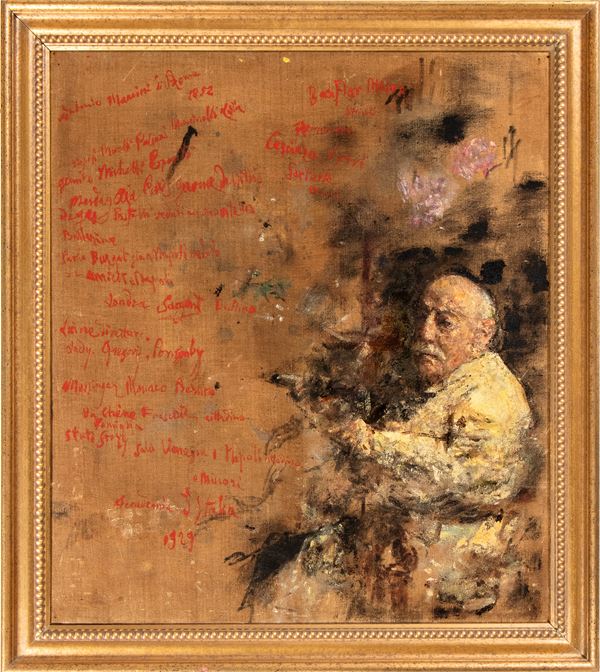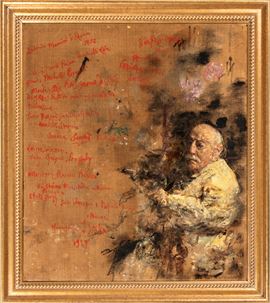ANTONIO MANCINI (Roma, 1852 - 1930)
Autobiographical self-portrait, 1929
Signed upper left: Antonio Mancini di Roma 1852, dated lower left 1929. On the back: Figura femminile (1929).
From the left: Antonio Mancini di Roma / 1852 / Napoli Morelli Palizzi Mancinelli Lista / Gemito Michetti Esposito / Mesdag Aja Paris Gerome De Nittis / Degas pastelli veduti al suo atelier / Ballerine / Paolo Bourget già a Napoli veduto / De Amicis a Napoli / Londra Sargent Dublino / Laine direttore / Lady Gregory Ponsonby / Messinger Monaco Berlino / Du Chéne Frascati cittadino / Famiglia/ Studi Story sala Venezia Napoli cittadino / a Minori; in the middle: Baca Flor pittore / amico/ peruviano / Casciaro Vetri Sartorio / amici; lower left: Accademia d’Italia 1929.
The painting is subjected to exportation ban outside Italy issued by the Italian Cultural Heritage Ministry.
Expertise by Prof. Cinzia Virno: "This very well-known self-portrait of Mancini is one of his last works and it is among the most important and emblematic paintings of his entire work. It is known as the “Biographical Self-Portrait” because the canvas is partly filled by the figure of the painter and partly filled by a long, bright red inscription, made by brush, which through names and events narrates his life. This is one of the the work in which he combines image and writing in the better way, two closely related components throughout his career. The painter made it in his studio at the Aventino in Rome at the end of 1929, exactly a year before his death. The artist depicts himself as an old man, sitting in the lower right corner. His face is three-quarter-length, his gaze pointed toward the viewer, while with his left hand he points to the inscription, inviting us to read it.
The light focuses on the face contrasting the dark shadow that envelops the evanescent figure delimiting its shape. Most of the surface, on the entire left side and up to the center, is filled by the words or phrases with a concise, essential and haphazard calligraphy, like that one we find in the diaries, writings and letters in his archive. These are quick notes, names and events given without any explanation, only listed in a minimal chronological order. The painter emphasizes that he is “from Rome,” born in 1852, and therefore not from Naples as he likes to reiterate in other works as well. However, he recalls the studies he made in the Neapolitan city, the teachers: Morelli, in primis, and Filippo Palizzi, Mancinelli, Lista; friends and fellow students: Gemito, Michetti, Esposito. Trips to Paris where he frequented Gérôme, De Nittis, and Degas-whose pastels he saw for sale in his studio-the critic and novelist Paul Bourget, a great admirer of his, whom he had already met in Naples. He mentions, still in Naples, meeting the writer Edmondo De Amicis, the author of the famous book “Cuore.”
He then mentions his Anglo-American acquaintances and travels to England and Ireland, recalling his friendships with: John Singer Sargent, who has been considered by him “the greatest living painter,” his friendship with the Irishman Hugh Lane, founder and director of the Dublin Gallery of Modern Art, now has been named after him, and with the latter's aunt, the writer and playwright, Lady Augusta Gregory. He also mentiones the antiquarian Claude Ponsonby. He still remembers the Roman studios of the American artists family Story: his father, the sculptor William Wetmore and his sons Thomas Waldo, also a sculptor, and Julian Russel, a painter. He then mentions his patron and main purchaser the Dutch marine painter Hendrik Willem Mesdag, who had bought many of his works, several of which appear today in the eponymous Museum “De Mesdag collectie,” in The Hague. German antiquarian Otto Messinger, has also been mentioned, with whom he had traveled to Munich and Berlin.
Frenchman Fernand Du Chéne de Vère, for whom he had worked in Frascati from 1911 to 1917. He then mentions younger artists: Giuseppe Casciaro, Paolo Vetri, Giulio Aristide Sartorio, and Peruvian student Carlos Baca Flor. Then he points to the events of his existence that he considers the most important: his solo exhibition at the 1920 Venice Biennale where all his works were sold, the honorary citizenship awarded to him by Frascati, Naples, and Minori. At the end he talks about the most recent event he was proud of: the appointment as “Accademico d’Italia” which he had just obtained. Stylistically and conceptually, the work is absolutely modern considering that Mancini was trained in an academic environment and in the midst of the nineteenth century. The half-lenght female figure sketched on the verso, in a low-cut dress, is his niece Domenica, the youngest daughter of his brother Giovanni, who posed for him, like his other nieces and nephews, from 1918.”
Cinzia Virno
Mancini's heirs
Antonio Mancini, Galleria Dedalo, catalogo della mostra, Milano, dal 14 dicembre 1939 , n. 22; Antonio Mancini e Vincenzo Gemito, Roma, Galleria d’Arte San Marco, 30 novembre-30 dicembre 1941, n. 22 ( Autoritratto con scritture); M. Biancale, Antonio Mancini / La vita, Fratelli Palombi editori, s.d. (ma 1952), pp. 7-8, 150, ripr. tav. f.t.; F. Sossi, Un grande dell’ultimo Ottocento / Antonio Mancini “ uno due e tre”, in “Il Meridionale”, Brindisi, 16 giugno 1956; Mostra di Antonio Mancini, introduzione di C. Lorenzetti, presentazione di F. Bellonzi, Milano, Villa Comunale, ottobre-novembre 1962, Colombi, Milano, 1962, p. 40, n. 71; D. Cecchi, Antonio Mancini, Torino, Utet, 1966, pp. 281-283, 330, ripr. tav. 50; V. Guzzi, Critica e Storia / a Valle Giulia, in “Il Tempo”, 4 maggio 1968; H. Pennock, Antonio Mancini en Nederland, Dordrecht, Dordrechts Museum, catalogo della mostra (In het licht van Mancini), Joh. Enschedé en Zonen, Haarlem 1987, pp. 62 ripr., 86, n. 60; Foto di gruppo / Antonio Mancini ed amici a Minori nell’estate del 1922, Catalogo della mostra a cura di M. Bignardi, Minori Aula Consiliare Agosto- 20 Settembre 1992, Ravello, Edizioni Il Punto, 1992, p. 9; V. Greene, F. Licht, S. Richardson, I. Wardropper, A Chisel and a Brush / Vincenzo Gemito 1852-1929 / Antonio Mancini 1852-1930 / From the Gilgore Collection italian Art 1850 - 1925, Catalogo della mostra, Naples (Florida), dicembre 2000, Elizabeth Franzen and Rachel Shuman Editors, p. 78, nota 45; Antonio Mancini / Nineteenth - Century / Italian Master / Celebrating the Vance N. Jordan Collection / at the Philadelphia Museum of Art, Catalogo a cura di U. W. Hiesinger, pubblicato in occasione della mostra al Philadelphia Museum of Art, 20 ottobre 2007 - 20 gennaio 2008, New Haven, CT: Yale University Press, 2007, p. 98, ripr. tav. 45; R. Smith, Tumultuous Mind, Spread Across Canvas, week end Arts, Fine Arts Leisure, in “The New York Times” 4 gennaio 2008., ripr. a p. 29; S. Bosi, C. Zanga in Antonio Mancini / Genio ribelle, Milano, Bottegantica, 21 ottobre-18 dicembre 2016, catalogo della mostra a cura di E. Savoia e S. Bosi; traduzione di A. Granato, Antiga Edizioni, Crocetta del Montello (TV) 2016, p. 155 n. 39 ripr. tav. 39 Alle pp. 118 – 119; C.Virno in Gemito, Mancini e il loro ambiente. Opere giovanili, GOMP, Roma, Palazzo Antonelli 19 maggio-16 giugno 2017, catalogo della mostra a cura di C. Virno e Manuel Carrera, Giacometti Old Master Paintings 2017, p. 24 C. Virno, Antonio Mancini / Catalogo ragionato dell’opere, La pittura a olio su tela, tavola, carta e specchio, De Luca editori d’arte, Roma 2019, vol. I, p. 28, fig. 37, tav. 85 a p. 98, p. 500, n. 1003 ripr.; vol. II, p. 527; Adrienne Quarles van Ufford, Mesdag & Mancini, Catalogo della mostra “Mancini. Eccentric & Extravagant” L’Aja, The Mesdag Collectiem 3giugno – 20 settembre 2020, ed. De Mesdag Collectie, L’Aja, 2020, pp. 35- 36, n. 11 ripr, pp. 88- 89, ripr.; A. Sferrazza, in M. Carrera, F. Mazzocca, C. Sisi, I. Valente ( a cura di), Antonio Mancini / Vincenzo Gemito, Pescara, Museo dell’Ottocento, Fondazione Di Persio – Pallotta, 14 ottobre 2023 – 11 marzo 2024, catalogo della mostra, Silvana Editoriale, Cinisello Balsamo, 2023, p. 324, n. 139 ripr. ( non esposto); Champion, Bellezza della materia da Mancini a Burri, in J- L. CS. Bellenger ( a cura di), Napoli Ottocento, Roma, Scuderie del Quirinale, 27 marzo – 16 giugno 2024, catalogo della mostra, Electa, Milano, 2024, pp. 349, p. 358, n. 224 ripr. e regesto delle opere, scheda di A. Sferrazza, ivi, p. 373.






